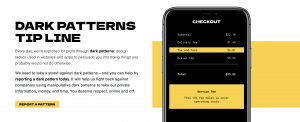Dark Patterns, Web Design, and Free Expression
 PEN America—along with Consumer Reports, the Electronic Frontier Foundation, Access Now, and others—launched the Dark Patterns Tip Line this week, a website where anyone can share examples of the websites that confuse and coerce us into making decisions or agreeing to terms that we wouldn’t otherwise.
PEN America—along with Consumer Reports, the Electronic Frontier Foundation, Access Now, and others—launched the Dark Patterns Tip Line this week, a website where anyone can share examples of the websites that confuse and coerce us into making decisions or agreeing to terms that we wouldn’t otherwise.
“Dark pattern” is a term that will be new to many outside the web design community, but is infamous within it. Dark patterns are design tactics used by websites and apps to trick or coerce you into doing things you probably would not do otherwise—a form where the “no, thanks” option is tiny gray text and “opt in” option is a big green button; dense legalese that you must accept in order to sign up for a service everyone is using; default settings that cause posts meant just for your friends to be broadcast to the world. Dark patterns finagle access to our address books and/or get us to “agree” to being tracked and listened to by seemingly benign apps. They make it hard to understand who has what access to our lives and the right to sell our data to others. Given companies’ interests in accruing more and more users and more and more data about them, it is no surprise that these malicious designs are everywhere. The Dark Patterns Tip Line is a campaign to raise awareness about dark patterns by letting any of us call them out. Together, we’ll make hoodwinking the public less appealing to companies.
At this point, it would be reasonable to ask why a free expression organization like PEN America is involved. The short answer: The way websites are designed shapes what information we read, how we can and choose to express ourselves, and how we are seen and surveilled online. When people express themselves online, it is always in the context of the terms and conditions they have knowingly or unknowingly signed off on. In an analogous way to how architecture and city planning can enable or restrict how we move and interact in public spaces, web design provides the space in which we read, speak, and are heard online. Design matters to free expression, the way a town square or a barricade matters to protest. As PEN America pointed out in our recent recommendations for improvements to social media platforms to stem online harassment and abuse, writers, journalists—in fact, all of us—“are caught in an increasingly untenable double bind,” between expressing ourselves online and exposing ourselves to potential surveillance, moderation, harassment, and targeted political and commercial advertising. The design of the websites and apps we use heavily impacts how much agency we have in the midst of all this.

A screenshot of the Dark Patterns Tip Line website at darkpatternstipline.org.
The Dark Patterns Tip Line is also timely because an increasing number of legislatures and regulatory bodies around are turning their attention to dark patterns. Much of the conversation in this area currently focuses on issues of consumer protection or privacy and “digital consent,” and intertwines with debates about content moderation, algorithmic bias, and censorship. While this conversation is still in its early days, it is nevertheless fast moving. For example, the California Consumer Privacy Act (CCPA) addresses dark patterns by requiring that “the notice of right to opt-out . . . be designed and presented in a way that is easy to read and understandable to consumers.” The European Union’s General Data Protection Regulation (GDPR) and proposed Digital Services Act (DSA) have related provisions, as does Senator Mark Warner’s bipartisan DETOUR Act. The U.S. Federal Trade Commission and several state attorneys general have shown an increasing appetite to highlight and act on the harms of deceptive digital products. The FTC’s recent hearing, “Bringing Dark Patterns to Light,” was seen by many as a harbinger of further action.
This debate over regulatory approaches to design is evolving quickly, and no clear consensus exists as to the best framing of the debate, let alone the answers that should come out of it. As the E.U.’s DSA puts it, “There is no objective definition of what ‘easy to access, timely, or user-friendly’ [design]” means in practice. But the harms are real, and the marketplace incentives point in the wrong direction. Here’s what we do know: Dark patterns rob people of their agency, and we’re going to change that. If we are going to address deceptive design and put users back in control of their privacy, their speech, and their lives online, we need to tell the story of how dark patterns are creating real confusion and real harms in our lives.
With the Dark Patterns Tip Line, PEN America and our partners are raising the visibility of a phenomenon that impacts virtually everyone who uses the internet and has significant ramifications for free expression and privacy from the individual to the global scale. We hope you’ll take a moment to read up, share with a friend, and call out pernicious web designs, in hopes of creating an internet where each of us controls more of what we see, say, and share.
Emma Fountain contributed to this piece.






